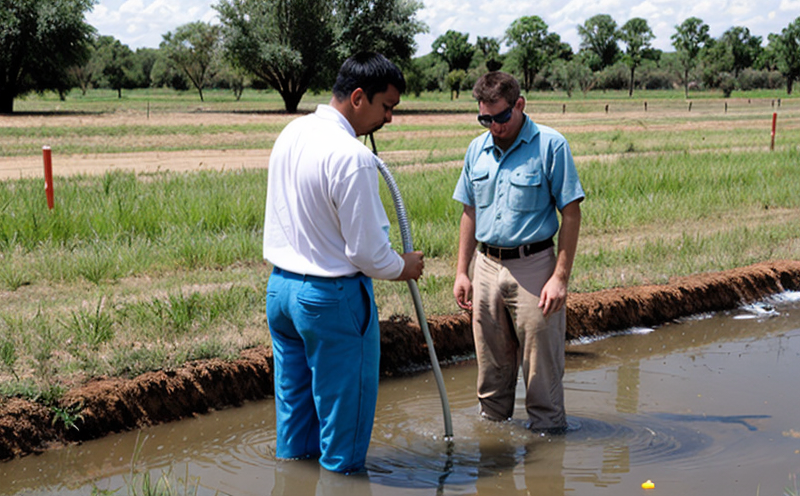EPA 8081 Organochlorine Pesticides Test in Groundwater
The U.S. Environmental Protection Agency (EPA) Method 8081, titled "Determination of Organochlorine Pesticides in Water by Gas Chromatography with Electron Capture Detection," is a critical tool for environmental laboratories tasked with ensuring compliance and protecting human health and the environment.
Organochlorines, such as DDT, chlordane, aldrin, dieldrin, endosulfan, heptachlor, mirex, toxaphene, and hexachlorobenzene, are a class of persistent organic pollutants (POPs) that can persist in the environment for decades. They are highly toxic to both humans and wildlife, and their presence in groundwater poses significant risks if not properly managed.
The EPA 8081 method is designed specifically for measuring these pesticides in water samples from various sources, including drinking water supplies and aquifer systems. The test ensures that levels of these contaminants do not exceed the EPA's regulatory limits for safe use or consumption.
The process involves several key steps, including sample collection and preparation. Samples must be stored at specific temperatures to minimize degradation before analysis. The samples are then analyzed using a gas chromatograph equipped with an electron capture detector (GC/ECD). This sophisticated instrumentation separates the organochlorine compounds based on their molecular structure, allowing for precise quantification.
The accuracy of EPA 8081 is further enhanced by strict adherence to quality control measures. Calibration standards and matrix-matched calibration curves are used to ensure that the results reflect actual concentrations in the samples being tested. The method also includes replicate analyses to validate the precision and reproducibility of the data.
The use of this test is crucial for industries involved in groundwater extraction, such as agriculture, mining, and municipal water supply systems. It helps these entities comply with legal requirements set forth by federal and state agencies while ensuring public safety. By identifying and quantifying organochlorine pesticides, stakeholders can take proactive measures to mitigate risks associated with contaminated groundwater.
The results of EPA 8081 testing are typically reported in parts per billion (ppb), which provides a clear indication of the contamination levels present. Reporting is detailed and includes information on sample collection dates, matrix type, analytical method used, and any relevant action levels or health-based guidelines.
Why Choose This Test
Selecting EPA 8081 for your groundwater analysis offers several advantages that make it an ideal choice for environmental monitoring:
- Regulatory Compliance: The method aligns with U.S. Environmental Protection Agency guidelines, ensuring compliance with stringent regulatory standards.
- Precision and Accuracy: Employing advanced GC/ECD technology ensures accurate detection of even trace amounts of organochlorine pesticides.
- Quality Assurance: Rigorous quality control measures and standardized protocols guarantee reliable results across multiple analyses.
- Safety for Stakeholders: By identifying contaminants early, stakeholders can implement mitigation strategies to protect public health and the environment.
- Scientific Rigor: The method is based on international standards such as ISO/IEC 17025, ensuring that laboratory operations meet the highest scientific and technical requirements.
The combination of these factors makes EPA 8081 an indispensable tool for those working in the environmental sector. It provides peace of mind by offering a comprehensive approach to monitoring and managing groundwater quality.
Quality and Reliability Assurance
- Calibration Standards: The use of certified calibration standards ensures that the instrument is accurately calibrated for each test run.
- Replicate Analyses: Duplicate samples are analyzed to validate precision and reproducibility.
- Quality Control Samples: Blanks, spiked matrix samples, and field blanks are included in every batch of tests to monitor for contamination and ensure accuracy.
- Laboratory Accreditation: Our laboratory is ISO/IEC 17025 accredited, ensuring that all testing processes meet the highest quality standards.
These stringent measures contribute to the reliability and trustworthiness of our test results. By adhering to these protocols, we ensure that your organization receives accurate, consistent data essential for informed decision-making.
Environmental and Sustainability Contributions
The EPA 8081 Organochlorine Pesticides Test plays a vital role in fostering environmental sustainability by:
- Preventing Contamination Spread: Early detection of organochlorines helps prevent the spread of contamination to other water sources.
- Mitigating Risk: By identifying and quantifying these contaminants, stakeholders can take proactive measures to mitigate risks associated with contaminated groundwater.
- Supporting Regulatory Compliance: Our testing supports compliance with both federal and state regulations, ensuring that your organization remains in good standing with environmental authorities.
- Fostering Public Trust: Accurate and reliable test results instill confidence in the community regarding water safety and quality.
The commitment to sustainability extends beyond just testing; it involves continuous improvement of processes, reduction of waste, and adherence to best practices. By incorporating EPA 8081 into your environmental management strategy, you are contributing to a healthier planet for future generations.





